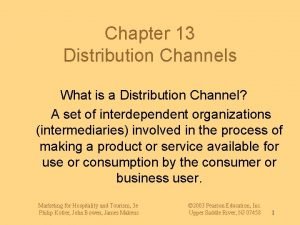Marketing Channels Delivering Customer Value 1 Supply Chains





































- Slides: 37

Marketing Channels Delivering Customer Value

1 -Supply Chains and the Value Delivery Network Producing a product or service and making it available to buyers requires building relationships not only with customers but also with key suppliers and resellers in the company’s Supply Chain. This supply chain consists of upstream and downstream partners. Upstream from the company is the set of firms that supply the raw materials, components, parts, information, finances, and expertise needed to create a product or service. § Marketers, however, have traditionally focused on the downstream side of the supply chain—on the marketing channels (or distribution channels) that look toward the customer. Downstream marketing channel partners, such as wholesalers and retailers, form a vital connection between the firm and its customers.





1 -Supply Chains and the Value Delivery Network The term supply chain may be too limited—it takes a make-and -sell view of the business. § It suggests that raw materials, productive inputs, and factory capacity should serve as the starting point for market planning. A better term would be Demand Chain because it suggests a sense-and-respond view of the market. § Under this view, planning starts by identifying the needs of target customers, to which the company responds by organizing a chain of resources and activities with the goal of creating customer value. Yet, even a Demand Chain view of a business may be too limited because it takes a step-by-step, linear view of purchaseproduction-consumption activities.

1 -Supply Chains and the Value Delivery Network With the advent of the Internet and other technologies, however, companies are now forming more numerous and complex relationships with other firms. § For example, Ford manages many supply chains—think about all the parts it takes to create a vehicle, from radios to catalytic converters to tires to transistors. § Ford also sponsors or transacts on many B-2 -B Web sites and online purchasing exchanges as needs arise. A Value Delivery Network is made up of the company, suppliers, distributors, and, ultimately, customers who “partner” with each other to improve the performance of the entire system. § For example, in making and marketing just one of its many models for the global market—say the Ford Escape hybrid— Ford manages a huge network of people within Ford plus thousands of suppliers and dealers outside the company who work together effectively to give final customers “the most fuel-efficient SUV on the market. ”

1 -Supply Chains and the Value Delivery Network We examine four major questions concerning marketing channels: a) What is the nature of marketing channels and why are they important? b) How do channel firms interact and organize to do the work of the channel? c) What problems do companies face in designing and managing their channels? d) What role do physical distribution and supply chain management play in attracting and satisfying customers?

2 -The Nature and Importance of Marketing Channels ØMarketing Channel (or distribution channel) Few producers sell their goods directly to final users, instead, most use intermediaries to bring their products to market. They try to forge a marketing channel (distribution channel)—a set of interdependent organizations that help make a product or service available for use or consumption by the consumer or business user. A company’s channel decisions directly affect every other marketing decision. § Pricing depends on whether the company works with national discount chains, uses high-quality specialty stores, or sells directly to consumers via the Web. The firm’s sales force and communications decisions depend on how much persuasion, training, motivation, and support its channel partners need.

2 -The Nature and Importance of Marketing Channels Marketing Channel (or distribution channel) Whether a company develops or acquires certain new products may depend on how well those products fit the capabilities of its channel members. § For example, Kodak initially sold its Easy Share printers only in Best Buy stores because of the retailer’s on-the-floor sales staff and their ability to educate buyers on the economics of paying a higher initial printer price but lower long-term ink costs. Companies often pay too little attention to their distribution channels—sometimes with damaging results. In contrast, many companies have used imaginative distribution systems to gain a competitive advantage. § Apple turned the retail music business on its head by selling music for the i. Pod via the Internet on i. Tunes. § And Fed. Ex’s creative and imposing distribution system made it a leader in express delivery.

2 -The Nature and Importance of Marketing Channels Marketing Channel (or distribution channel) Distribution channel decisions often involve long-term commitments to other firms. § For example, companies such as Ford, Mc. Donald’s, or HP can easily change their advertising, pricing, or promotion programs. § They can scrap old products and introduce new ones as market tastes demand. But when they set up distribution channels through contracts with franchisees, independent dealers, or large retailers, they cannot readily replace these channels with company-owned stores or Web sites if the conditions change. Therefore, management must design its channels carefully, with an eye on both tomorrow’s likely selling environment and today’s.

2 -The Nature and Importance of Marketing Channels Ø How Channel Members Add Value Why do producers give some of the selling job to channel partners? After all, doing so means giving up some control over how and to whom they sell their products. Producers use intermediaries because they create greater efficiency in making goods available to target markets. Through their contacts, experience, specialization, and scale of operation, intermediaries usually offer the firm more than it can achieve on its own. Figure 12. 1 shows how using intermediaries can provide economies. Figure 12. 1 A shows three manufacturers, each using direct marketing to reach three customers, this system requires nine different contacts. Figure 12. 1 B shows the three manufacturers working through one distributor, which contacts the three customers, this system requires only six contacts. In this way, intermediaries reduce the amount of work that must be done by both producers and consumers.


2 -The Nature and Importance of Marketing Channels How Channel Members Add Value From the economic system’s point of view, the role of marketing intermediaries is to transform the assortments of products made by producers into the assortments wanted by consumers. Producers make narrow assortments of products in large quantities, but consumers want broad assortments of products in small quantities. Marketing channel members buy large quantities from many producers and break them down into the smaller quantities and broader assortments desired by consumers. For example, Unilever makes millions of bars of Lever 2000 hand soap each week, but you want to buy only a few bars at a time. So big food, drug, and discount retailers, such as Kroger, Walgreens, and Target, buy Lever 2000 by the truckload and stock it on their stores’ shelves.

2 -The Nature and Importance of Marketing Channels How Channel Members Add Value In turn, you can buy a single bar of Lever 2000, along with a shopping cart full of small quantities of toothpaste, shampoo, and other related products as you need them. Thus, intermediaries play an important role in matching supply and demand. In making products and services available to consumers, channel members add value by bridging the major time, place, and possession gaps that separate goods and services from those who use them. Members of the marketing channel perform many key functions, some help to complete transactions:

2 -The Nature and Importance of Marketing Channels How Channel Members Add Value • Information: Gathering and distributing marketing research and intelligence information about actors and forces in the marketing environment needed for planning and aiding exchange. • Promotion: Developing and spreading persuasive communications about an offer. • Contact: Finding and communicating with prospective buyers. • Matching: Shaping and fitting the offer to the buyer’s needs, including activities such as manufacturing, grading, assembling, and packaging. Negotiation: Reaching an agreement on price and other terms of the offer so that ownership or possession can be transferred. Others help to fulfill the completed transactions: • Physical distribution: Transporting and storing goods. • Financing: Acquiring and using funds to cover the costs of the channel work. • Risk taking: Assuming the risks of carrying out the channel work.

2 -The Nature and Importance of Marketing Channels How Channel Members Add Value The question is not whether these functions need to be performed—they must be—but rather who will perform them. To the extent that the manufacturer performs these functions, its costs go up, and, therefore, its prices must be higher. When some of these functions are shifted to intermediaries, the producer’s costs and prices may be lower, but the intermediaries must charge more to cover the costs of their work. In dividing the work of the channel, the various functions should be assigned to the channel members who can add the most value for the cost.

2 -The Nature and Importance of Marketing Channels ØNumber of Channel Levels Companies can design their distribution channels to make products and services available to customers in different ways. Each layer of marketing intermediaries that performs some work in bringing the product and its ownership closer to the final buyer is a channel level. Because both the producer and the final consumer perform some work, they are part of every channel. The number of intermediary levels indicates the length of a channel. [Figure 12. 2 A] Channel 1, called a Direct Marketing Channel, has no intermediary levels; the company sells directly to consumers. For example, Mary Kay Cosmetics and Amway sell their products door- to-door, through home and office sales parties, and on the Internet; GEICO sells insurance direct via the telephone and the Internet.


2 -The Nature and Importance of Marketing Channels Number of Channel Levels The remaining channels in Figure 12. 2 A are Indirect Marketing Channels, containing one or more intermediaries. Figure 12. 2 B shows some common business distribution channels. The business marketer can use its own sales force to sell directly to business customers, or it can sell to various types of intermediaries, who in turn sell to these customers. Consumer and business marketing channels with even more levels can sometimes be found, but these are less common. From the producer’s point of view, a greater number of levels means less control and greater channel complexity. Moreover, all the institutions in the channel are connected by several types of flows, these include the physical flow of products, the flow of ownership, the payment flow, the information flow, and the promotion flow. These flows can make even channels with only one or a few levels very complex.

4 -Channel Design Decisions In designing marketing channels, manufacturers struggle between what is ideal and what is practical. § A new firm with limited capital usually starts by selling in a limited market area. Deciding on the best channels might not be a problem: § The problem might simply be how to convince one or a few good intermediaries to handle the line. If successful, the new firm can branch out to new markets through existing intermediaries. § In smaller markets, the firm might sell directly to retailers; in larger markets, it might sell through distributors. § In one part of the country, it might grant exclusive franchises; in another, it might sell through all available outlets.

4 -Channel Design Decisions § Then it might add a web store that sells directly to hard-to- reach customers. In this way, channel systems often evolve to meet market opportunities and conditions. For maximum effectiveness, however, channel analysis and decision making should be more purposeful. Marketing channel design calls for analyzing consumer needs, setting channel objectives, identifying major channel alternatives, and evaluating those alternatives.

4 -Channel Design Decisions ØAnalyzing Consumer Needs Marketing channels are part of the overall Customer-value Delivery Network. Each channel member and level adds value for the customer, thus, designing the marketing channel starts with finding out what target consumers want from the channel: ü Do consumers want to buy from nearby locations or are they willing to travel to more distant and centralized locations? ü Would customers rather buy in person, by phone, or online? ü Do they value breadth of assortment or do they prefer specialization? ü Do consumers want many add-on services (delivery, installation, repairs), or will they obtain these services elsewhere? The faster the delivery, the greater the assortment provided, and the more add-on services supplied, the greater the channel’s service level.

4 -Channel Design Decisions Analyzing Consumer Needs Providing the fastest delivery, the greatest assortment, and the most services may not be possible or practical. The company and its channel members may not have the resources or skills needed to provide all the desired services, also, providing higher levels of service results in higher costs for the channel and higher prices for consumers. For example, your local hardware store probably provides more personalized service, a more convenient location, and less shopping hassle than the nearest huge Home Depot or Lowe’s store, but it may also charge higher prices. The company must balance consumer needs not only against the feasibility and costs of meeting these needs but also against customer price preferences. The success of discount retailing shows that consumers will often accept lower service levels in exchange for lower prices.

4 -Channel Design Decisions ØSetting Channel Objectives Companies should state their marketing channel objectives in terms of targeted levels of customer service. § Usually, a company can identify several segments wanting different levels of service. § The company should decide which segments to serve and the best channels to use in each case. § In each segment, the company wants to minimize the total channel cost of meeting customer-service requirements. The company’s channel objectives are also influenced by the nature of the company, its products, its marketing intermediaries, its competitors, and the environment. § For example, the company’s size and financial situation determine which marketing functions it can handle itself and which it must give to intermediaries.

4 -Channel Design Decisions Setting Channel Objectives Companies selling perishable products may require more direct marketing to avoid delays and too much handling. In some cases, a company may want to compete in or near the same outlets that carry competitors’ products. § For example, Maytag wants its appliances displayed alongside competing brands to facilitate comparison shopping. § In other cases, companies may avoid the channels used by competitors. Finally, environmental factors such as economic conditions and legal constraints may affect channel objectives and design. § For example, in a depressed economy, producers want to distribute their goods in the most economical way, using shorter channels and dropping unneeded services that add to the final price of the goods.

4 -Channel Design Decisions ØIdentifying Major Alternatives When the company has defined its channel objectives, it should next identify its major channel alternatives in terms of: üThe Types of intermediaries, üThe Number of intermediaries, and üThe Responsibilities of each channel member.

4 -Channel Design Decisions Identifying Major Alternatives ØTypes of Intermediaries A firm should identify the types of channel members available to carry out its channel work. Most companies face many channel member choices. § For example, Dell sold directly to final consumers and business buyers only through its sophisticated phone and Internet marketing channel. § It also sold directly to large corporate, institutional, and government buyers using its direct sales force. § To reach more consumers and match competitors such as HP, dell now sells indirectly through retailers such as best buy, staples, and Walmart. § It also sells indirectly through value-added resellers, independent distributors and dealers who develop computer systems and applications tailored to the special needs of small- and mediumsized business customers.

4 -Channel Design Decisions Identifying Major Alternatives Types of Intermediaries Using many types of resellers in a channel provides both benefits and drawbacks. § For example, by selling through retailers and value-added resellers in addition to its own direct channels, Dell can reach more and different kinds of buyers. § However, the new channels will be more difficult to manage and control. § And the direct and indirect channels will compete with each other for many of the same customers, causing potential conflict. § In fact, Dell often finds itself “stuck in the middle, ” with its direct sales reps complaining about competition from retail stores, while its value-added resellers complain that the direct sales reps are undercutting their business.

4 -Channel Design Decisions Identifying Major Alternatives ØNumber of Marketing Intermediaries Companies must also determine the number of channel members to use at each level, three strategies are available: v Intensive Distribution Producers of convenience products and common raw materials typically seek intensive distribution—a strategy in which they stock their products in as many outlets as possible. These products must be available where and when consumers want them. § § For example, toothpaste, candy, and other similar items are sold in millions of outlets to provide maximum brand exposure and consumer convenience. Kraft, Coca-Cola, Kimberly-Clark, and other consumer-goods companies distribute their products in this way.

4 -Channel Design Decisions Identifying Major Alternatives Number of Marketing Intermediaries v Exclusive Distribution By contrast, some producers purposely limit the number of intermediaries handling their products. The extreme form of this practice is Exclusive Distribution, in which the producer gives only a limited number of dealers the exclusive right to distribute its products in their territories. Exclusive distribution is often found in the distribution of luxury brands. § § For example, exclusive Bentley automobiles are typically sold by only a handful of authorized dealers in any given market area. By granting exclusive distribution, Bentley gains stronger dealer selling support and more control over dealer prices, promotion, and services. Exclusive distribution also enhances the brand’s image and allows for higher markups.

4 -Channel Design Decisions Identifying Major Alternatives Number of Marketing Intermediaries v. Selective Distribution. Between intensive and exclusive distribution lies Selective Distribution—the use of more than one but fewer than all the intermediaries who are willing to carry a company’s products. Most television, furniture, and home appliance brands are distributed in this manner. § § For example, Whirlpool and GE sell their major appliances through dealer networks and selected large retailers. By using selective distribution, they can develop good working relationships with selected channel members and expect a better-than-average selling effort. Selective distribution gives producers good market coverage with more control and less cost than does intensive distribution.

4 -Channel Design Decisions Identifying Major Alternatives ØResponsibilities of Channel Members The producer and the intermediaries need to agree on the terms and responsibilities of each channel member. They should agree on price policies, conditions of sale, territory rights, and the specific services to be performed by each party. The producer should establish a list price and a fair set of discounts for the intermediaries. It must define each channel member’s territory, and it should be careful about where it places new resellers. Mutual services and duties need to be spelled out carefully, especially in franchise and exclusive distribution channels. § For example, Mc. Donald’s provides franchisees with promotional support, a record-keeping system, training. § In turn, franchisees must meet company standards for physical facilities and food quality, cooperate with new promotion programs, provide requested information, and buy specified food products.

4 -Channel Design Decisions Identifying Major Alternatives ØEvaluating the Major Alternatives Suppose a company has identified several channel alternatives and wants to select the one that will best satisfy its long-run objectives. Each alternative should be evaluated against economic, control, and adaptability criteria. Using economic criteria, a company compares the likely sales, costs, and profitability of different channel alternatives. § What will be the investment required by each channel alternative, and what returns will result? The company must also consider control issues. Using intermediaries usually means giving them some control over the marketing of the product, and some intermediaries take more control than others.

4 -Channel Design Decisions Identifying Major Alternatives Evaluating the Major Alternatives Other things being equal, the company prefers to keep as much control as possible. Finally, the company must apply adaptability criteria. § Channels often involve long-term commitments, yet the company wants to keep the channel flexible so that it can adapt to environmental changes. Thus, to be considered, a channel involving long-term commitments should be greatly superior on economic and control grounds.

4 -Channel Design Decisions ØDesigning International Distribution Channels International marketers face many additional complexities in designing their channels: § Each country has its own unique distribution system that has evolved over time and changes very slowly. § These channel systems can vary widely from country to country, thus, global marketers must usually adapt their channel strategies to the existing structures within each country. § In some markets, the distribution system is complex and hard to penetrate, consisting of many layers and large numbers of intermediaries. § International marketers face a wide range of channel alternatives. § Designing efficient and effective channel systems between and within various country markets poses a difficult challenge.
 Marketing channels: delivering customer value
Marketing channels: delivering customer value Marketing channels delivering customer value
Marketing channels delivering customer value Marketing channels delivering customer value
Marketing channels delivering customer value Multi channel distribution
Multi channel distribution Customer value satisfaction and retention
Customer value satisfaction and retention Designing customer oriented marketing channels
Designing customer oriented marketing channels Vertical
Vertical Marketing channels and supply chain management
Marketing channels and supply chain management Supply chain management and marketing channels
Supply chain management and marketing channels Vertical marketing
Vertical marketing What is a marketing channel system and value network
What is a marketing channel system and value network Delivering business value with it at hefty hardware
Delivering business value with it at hefty hardware Delivering business value with it
Delivering business value with it Managing supply chains a logistics approach
Managing supply chains a logistics approach Managing supply chains: a logistics approach
Managing supply chains: a logistics approach Managing supply chains a logistics approach
Managing supply chains a logistics approach Managing supply chains a logistics approach
Managing supply chains a logistics approach Agile supply chain characteristics
Agile supply chain characteristics Marketing creating customer value and engagement
Marketing creating customer value and engagement Target marketing strategies
Target marketing strategies An expanded model of the marketing process
An expanded model of the marketing process Contoh value creation adalah
Contoh value creation adalah Marketing distribution channel
Marketing distribution channel Definition marketing channel
Definition marketing channel Physical marketing channels
Physical marketing channels Global marketing channel
Global marketing channel Steps in channel design
Steps in channel design Marketing distribution channel
Marketing distribution channel Indirect marketing channel
Indirect marketing channel Specialty channel marketing
Specialty channel marketing Marketing channel concepts
Marketing channel concepts 12 principles of distribution channel management
12 principles of distribution channel management Alternative marketing channels
Alternative marketing channels Home country middlemen
Home country middlemen Marketing channels for services
Marketing channels for services Variables affecting channel structure
Variables affecting channel structure High value deal seekers
High value deal seekers Integrated marketing channel system
Integrated marketing channel system

























































